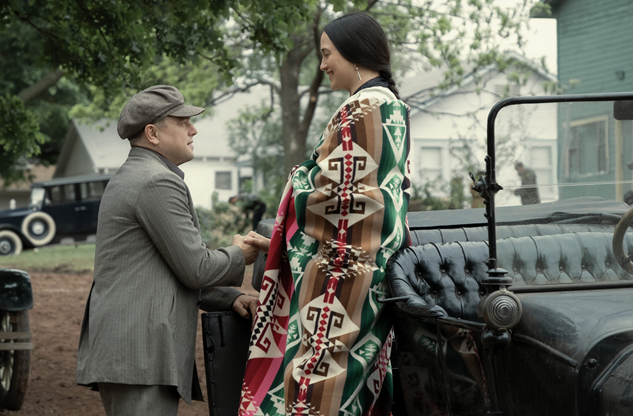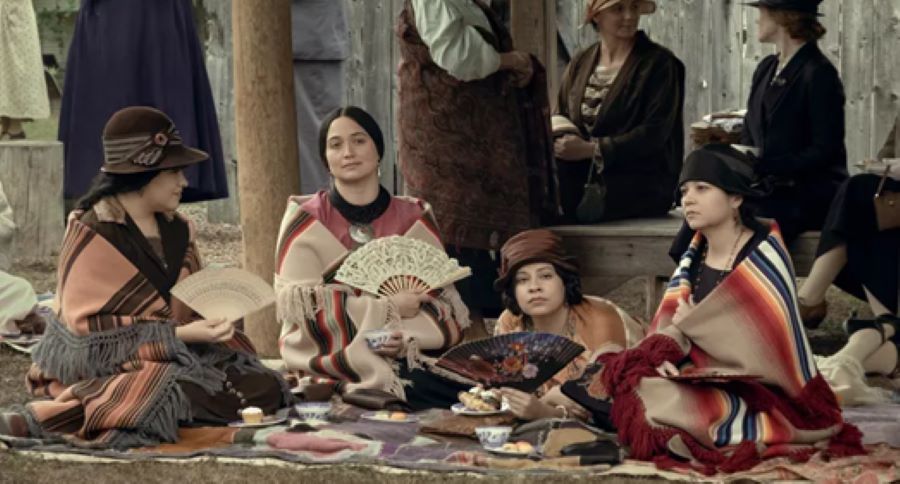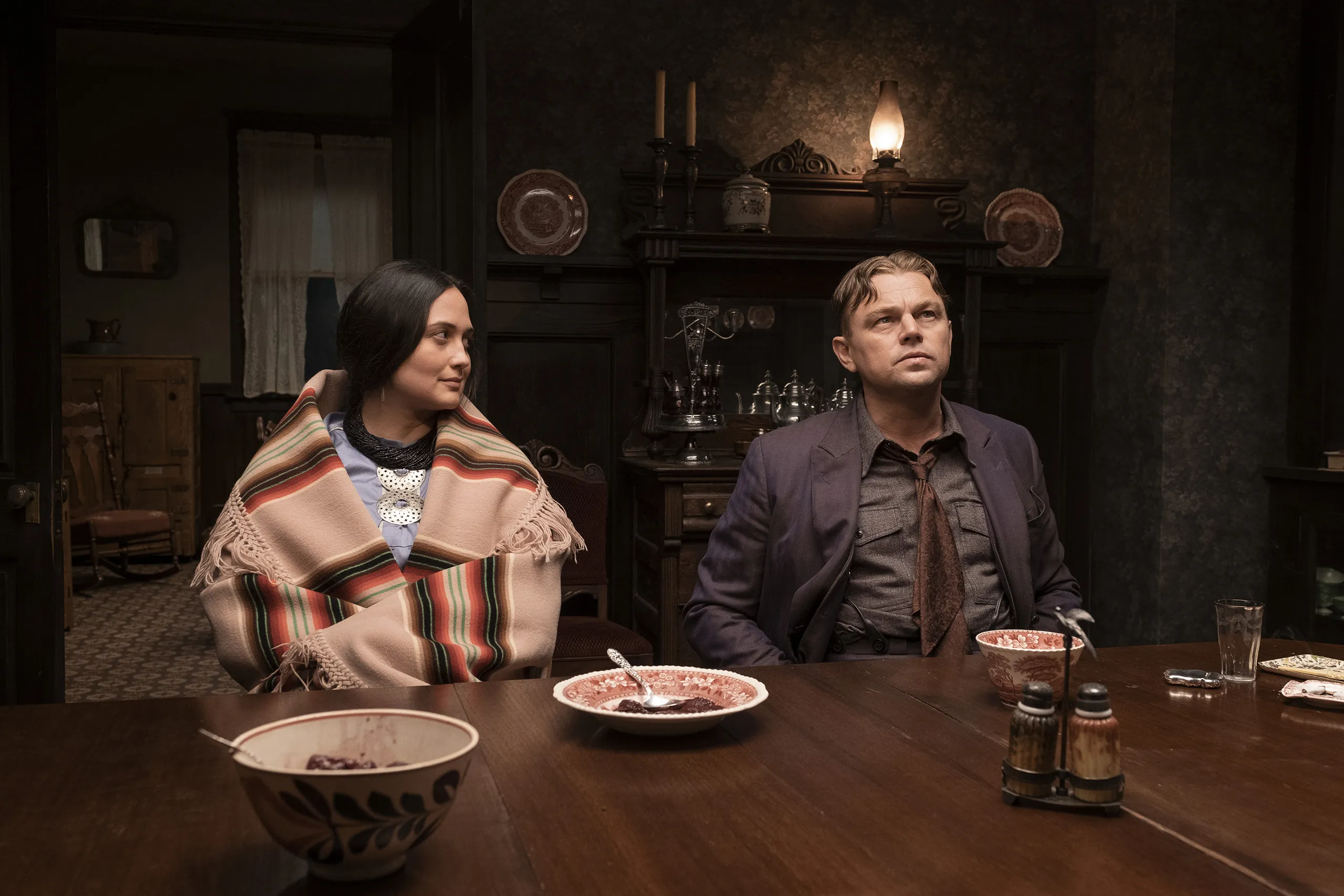
Killers of the Flower Moon, an adaptation of David Grann’s book of the same name, is Scorsese’s magnum opus and, arguably, his greatest creation ever
Lover, thief, filmmaker. At their most suave, they are all trying to seduce you. At their most deft, they are all manipulators. At their most exposed, they are all romantics. In Killers of the Flower Moon, Martin Scorsese’s latest contribution to cinema, the lover, the thief, and the filmmaker’s perspectives all blur into one and narrate a dreadful portion of American history in the most cinematic way possible.
An adaptation of David Grann’s book of the same name, Killers of the Flower Moon is set around the Osage Indian murders that took place between 1918 and 1931. After the discovery of oil in Osage Indian Territory, the Native American people who acquired riches from the oil began to get murdered in a master effort by the white intruders. It’s a gut-wrenching and little-known tale that needed a robust narrative on screen. “It’s the story of America, and the story of colonialism”— and who better than the greatest living filmmaker to replicate the story of America — a country built by settlers who stole the land from its people.

At the twilight of his career, half a century after he started the everlasting camaraderie with Scorsese in Mean Streets, Robert De Niro dominates the screen as the devilish cattle chief Bill ‘King’ Hale, an unusual patriarch of the town of Fairfax, Oklahoma. The crux of the excruciating tale is the story of the women: the strong, silent centre of a narrative controlled by white men where this certain old man in particular played the part of a colonising puppeteer with utmost finesse.
Leonardo DiCaprio embraces his role as De Niro’s acquisitive and dim-witted factotum nephew whose usefulness depends on how efficiently he keeps his uncle’s hand clean as he embarks on a pre-meditated murderous mission to eradicate an entire family — an entire community, in turn — in pursuit of wealth. DiCaprio’s Ernest Burkhart is a cold-blooded rational criminal, a typical free-flowing Scorsese antagonist.
Bill Hale is a monster; arguably one of De Niro’s most sinister, ‘King’ paints himself as the Osage people’s friend and greatest ally; he is well versed in the native language, effortlessly dedicates favours, and even delivers heartfelt funeral orations — after murders instigated by himself. He is scary to the truest sense of the word, a wolf ready to prey, a principal character in the story. His reliable stooge Ernest Burkhart takes an Osage bride, Mollie. His intention, as with all his other intentions, is far from altruistic: it’s to ensure that Mollie and her family — sisters and children — never inherit the multi-million dollar oil rights owned by her elderly and ailing mother. While De Niro DiCaprio excel as the letter A in acting, the retaliation against them is a revelation.

Lily Gladstone as Mollie Burkhart. Words will fall short of describing the range she has displayed on the screen, every frame she was in — she made it magnetic, she owned it, stood her ground, and stood out amongst the few legendaries. Gladstone’s Mollie falls prey to the blue-eyed coyote Ernest, eventually her trial and suffering became the core of the story. Gladstone brought a succinct grounded humanitarian touch to the story which is unparalleled and otherworldly, never melodramatic and always in the truth of her character — she excels as one of the lovers of the flower moon.
But the love is also grim and cold, despite being a love story at its core, the romance between Ernest and Mollie is torturous, exasperating, and simply doesn’t sit right because of the cruelty that has been enforced and the ulterior motives which have been exposed. Why the film has been labelled as a difficult watch is majorly for this reason: the love that is given is the love that is lost. Mollie’s unwavering affection towards Ernest is frustrating and painful, yet her resilience makes it outstanding and a lesson in moral conflict. Gladstone goes up to the very top of Scorsese’s leading women’s list with this tour de force stint.
The whole ensemble understands the element that this is neither a thorough history lesson nor a typical mafia-gang-war-thriller. Everyone involved in making this film is committed to exposing a shameful tragedy that is overlooked in textbooks. Scorsese and screenwriter Eric Roth took a book that’s explicitly about the creation of the F.B.I. by way of the investigation into the Osage murders and shifted the storytelling to a more personal perspective for both Mollie and Ernest. It resonates with the narrative of how this effortless massacre against people deemed lesser pervaded a century of horror. The references made to the Tulsa Massacre and the Ku Klux Klan are all part of the big picture — one of people who subjugate because it’s so easy for them to do so. Killers of the Flower Moon is supposed to anger you, appal you, and make you determined for a better society.

Deep into his career, 56 years in, after countless masterpieces and film study materials, Martin Scorsese packs a punch so powerful that completes his filmography. Killers of the Flower Moon will be dissected frame by frame for the hidden metaphors and niche camera techniques, as a modern Western classic etcetera. However, in this age of riding bandwagons and selective activism on social media, picking up a subject so sensitive and representing the indigenous without sugar-coating their harrowing experiences, while being true to his cinematic calibre, there is only one Scorsese for that. In early days, he has glamourised and patronised the mafia in the same film, he has gone beyond and issued a strong statement in the most brilliant way possible with his flower moon. A legend and beyond in his craft, a filmmaker who doesn’t spoon-feed his audience yet demands their utmost association. Killers of the Flower Moon is Scorsese’s magnum opus and, arguably, his greatest creation ever.
Honorary mention to the late Robbie Robertson’s ominous creepy music which worked as a de-facto protagonist on its own; the heartbeat-esque background added that extra urgency and fear to an already overcast premise. The legendary Thelma Schoonmaker, a longtime collaborator of Scorsese’s, returns to edit this colossus of a project. Despite the lengthy runtime, never for once does the film lose its grip, its sense of compassion or its deadliness. Rodrigo Pietro’s genius cinematography highlights the ideas of greed in how he captures the sweeping country landscapes of Osage Nation, emphasising its luscious beauty while also painting it as a hotbed of crimes, absolutely justifying the IMAX treatment.
The film resembles a complex creative puzzle; once solved, it’s brutally clear to distinguish the thieves, the lovers and the filmmaker’s intent. Scorsese makes his regular cameo and ends with a deliberate tease — “There were no mentions of the murders” — as he reads Mollie’s fate, he breaks the fourth wall and makes it so meta with profundity. That’s where you know that cinema is back on the big screen. Please never stop making films, Martin Scorsese
More from Culture
Comments
*Comments will be moderated









-thumbs.jpg)

